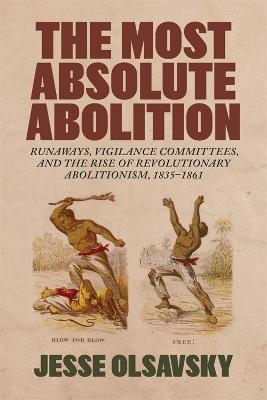
The Most Absolute Abolition
Runaways, Vigilance Committees, and the Rise of Revolutionary Abolitionism, 1835–1861
Seiten
2022
Louisiana State University Press (Verlag)
978-0-8071-7730-3 (ISBN)
Louisiana State University Press (Verlag)
978-0-8071-7730-3 (ISBN)
Tells the dramatic story of how vigilance committees organised the Underground Railroad and revolutionized the abolitionist movement. Jesse Olsavsky reveals how the committees cultivated a movement of ideas animated by a motley assortment of agitators and intellectuals who shared critical information with one another.
Jesse Olsavsky's The Most Absolute Abolition tells the dramatic story of how vigilance committees organized the Underground Railroad and revolutionized the abolitionist movement. These groups, based primarily in northeastern cities, defended Black neighborhoods from police and slave catchers. As the urban wing of the Underground Railroad, they helped as many as ten thousand refugees, building an elaborate network of like-minded sympathizers across boundaries of nation, gender, race, and class.
Olsavsky reveals how the committees cultivated a movement of ideas animated by a motley assortment of agitators and intellectuals, including famous figures such as Frederick Douglass, Harriet Tubman, and Henry David Thoreau, who shared critical information with one another. Formerly enslaved runaways—who grasped the economy of slavery, developed their own political imaginations, and communicated strategies of resistance to abolitionists—serve as the book's central focus. The dialogues between fugitives and abolitionists further radicalized the latter's tactics and inspired novel forms of feminism, prison reform, and utopian constructs. These notions transformed abolitionism into a revolutionary movement, one at the heart of the crises that culminated in the Civil War.
Jesse Olsavsky's The Most Absolute Abolition tells the dramatic story of how vigilance committees organized the Underground Railroad and revolutionized the abolitionist movement. These groups, based primarily in northeastern cities, defended Black neighborhoods from police and slave catchers. As the urban wing of the Underground Railroad, they helped as many as ten thousand refugees, building an elaborate network of like-minded sympathizers across boundaries of nation, gender, race, and class.
Olsavsky reveals how the committees cultivated a movement of ideas animated by a motley assortment of agitators and intellectuals, including famous figures such as Frederick Douglass, Harriet Tubman, and Henry David Thoreau, who shared critical information with one another. Formerly enslaved runaways—who grasped the economy of slavery, developed their own political imaginations, and communicated strategies of resistance to abolitionists—serve as the book's central focus. The dialogues between fugitives and abolitionists further radicalized the latter's tactics and inspired novel forms of feminism, prison reform, and utopian constructs. These notions transformed abolitionism into a revolutionary movement, one at the heart of the crises that culminated in the Civil War.
| Erscheinungsdatum | 11.07.2022 |
|---|---|
| Zusatzinfo | 6 illustrations |
| Verlagsort | Baton Rouge |
| Sprache | englisch |
| Maße | 152 x 229 mm |
| Gewicht | 151 g |
| Themenwelt | Geisteswissenschaften ► Geschichte ► Regional- / Ländergeschichte |
| Geschichte ► Teilgebiete der Geschichte ► Militärgeschichte | |
| Sozialwissenschaften ► Ethnologie | |
| Sozialwissenschaften ► Soziologie ► Makrosoziologie | |
| ISBN-10 | 0-8071-7730-X / 080717730X |
| ISBN-13 | 978-0-8071-7730-3 / 9780807177303 |
| Zustand | Neuware |
| Haben Sie eine Frage zum Produkt? |
Mehr entdecken
aus dem Bereich
aus dem Bereich
neueste Manipulationstechniken als Waffengattung der NATO
Buch | Softcover (2023)
Westend (Verlag)
CHF 33,55
Deutschlands Schwäche in der Zeitenwende
Buch | Softcover (2023)
C.H.Beck (Verlag)
CHF 25,20


